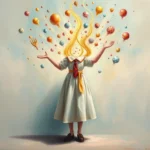
Dreams can be enigmatic, often reflecting the complexities of our waking lives in ways that are both fascinating and perplexing. For those on the autism spectrum, dreams may serve as a unique canvas where experiences, emotions, and challenges merge. Understanding how autism manifests in dreams can provide insight into one’s psyche, offering clues about unspoken feelings and thoughts that may not surface in daily life. Whether you are on the spectrum yourself or supporting someone who is, exploring these dreamscapes can foster deeper understanding and empathy.
As we delve into the world of dreams related to autism, we’ll explore the symbolism that emerges, the various scenarios that may unfold, and the potential for personal growth that lies within these nocturnal narratives. Let’s embark on this journey together and see what wisdom our dreams may hold.
The Spectrum of Symbols: Decoding the Dream Language
In the realm of dreams, symbols act as the language of the subconscious, revealing deeper layers of our experiences. For individuals with autism, the symbols that appear in dreams may reflect their unique perspectives and experiences. Dreams can serve as both a mirror and a window, showcasing the internal landscape of emotions and perceptions.
One prevalent symbol in dreams related to autism might be masks. In a dream, wearing a mask could represent the social facades that many individuals on the spectrum feel compelled to adopt. This symbolism highlights the contrast between their true selves and the personas they present to the world. It speaks to the struggle of navigating social situations where they may feel misunderstood or out of sync with societal expectations.
Additionally, bridges often emerge as powerful symbols, representing the connections—or lack thereof—between the dreamer and others. For someone on the autism spectrum, a bridge in a dream may signify an opportunity for connection or a journey toward greater understanding, either of themselves or their relationships with others. Conversely, if the bridge is broken or unstable, it might reflect feelings of isolation or the challenge of building meaningful connections.
Another common symbol is water, often associated with emotions and the subconscious. For those with autism, water may take on different forms—calm seas might represent a sense of peace and acceptance, while turbulent waters could indicate anxiety or overwhelm. Understanding the nature of the water in their dreams can provide insights into their emotional state and coping mechanisms.
Furthermore, rooms are significant symbols in dreams that can represent various aspects of the self. A cluttered room might signify a mind filled with overwhelming thoughts and emotions, while an organized space could reflect clarity and control. The condition and layout of these rooms can reveal much about how individuals perceive their internal world, including their feelings about self-identity and social interactions.
Lastly, light plays a crucial role in dream symbolism. For someone on the spectrum, light might symbolize clarity, understanding, or moments of realization. Conversely, darkness could represent confusion, fear, or feelings of being lost. Analyzing how light and dark manifest in dreams can shed light on one’s emotional journey and personal growth.
Dreamscapes of the Mind: Scenarios from the Spectrum
Dreams can manifest in various scenarios, each offering a glimpse into the dreamer’s thoughts and feelings. Here are several illustrative examples that highlight how autism might unfold in dreams:
1. The Unfinished Puzzle
In this dream, the dreamer finds themselves in a room filled with pieces of a large jigsaw puzzle. Despite their best efforts, they can’t seem to fit the pieces together. This scenario may reflect the dreamer’s feelings of confusion and frustration in social situations or aspects of their life that feel incomplete. It symbolizes the struggle to make sense of their experiences or connect with others on a deeper level. The dream could be a call to seek help or collaboration in addressing these challenges.
2. The Social Gathering
Imagine a dream where the dreamer is at a lively party, surrounded by people engaging in conversation. However, the dreamer feels out of place, unable to join in or connect with anyone. This scenario might point to the anxiety and sensory overload that often accompany social interactions for individuals on the spectrum. It serves as a reminder to honor one’s feelings and needs, while also reflecting the desire for connection despite the challenges.
3. The Maze
In this dream, the dreamer navigates a complex maze with high walls. They encounter various obstacles, yet they persist in finding their way out. This scenario symbolizes the journey of self-discovery and personal growth. It can represent the challenges faced in understanding oneself or the world, but also the determination to overcome these hurdles. The maze may remind the dreamer that while the path may be winding, perseverance can lead to clarity and understanding.
4. The Flying Experience
In another dream, the dreamer suddenly finds themselves soaring through the sky, free and unencumbered. This scenario reflects a sense of liberation and empowerment, showcasing the dreamer’s desire to break free from societal constraints or self-imposed limitations. It may symbolize the innate strengths and talents of individuals on the spectrum, encouraging them to embrace their uniqueness and soar to new heights.
5. The Missing Voice
In this dream, the dreamer attempts to speak but finds that no sound comes out. This experience can represent feelings of frustration and being unheard, which many individuals with autism may relate to. It highlights the struggle to communicate thoughts and emotions, emphasizing the importance of finding one’s voice—whether through verbal communication, art, or other outlets. This dream serves as a reminder of the power of expression and the need for acceptance.
Beyond the Dream: Pathways to Personal Growth
Dreams are not just fleeting nighttime experiences; they hold the potential for personal growth and self-discovery. By reflecting on the themes and symbols present in their dreams, individuals on the autism spectrum can gain valuable insights into their emotions, challenges, and aspirations.
One of the first steps in harnessing the power of dreams is to keep a dream journal. Documenting dreams upon waking can help capture fleeting thoughts and emotions that might otherwise be forgotten. Over time, patterns may emerge, revealing recurring symbols or themes that warrant further exploration. This practice can foster a deeper understanding of oneself and serve as a valuable tool for personal growth.
Additionally, engaging in mindfulness practices can enhance dream recall and awareness. By cultivating a sense of presence in waking life, individuals may find that they become more attuned to their dreams and the messages they convey. Techniques such as meditation or deep breathing can also help reduce anxiety, creating a more conducive environment for peaceful sleep and meaningful dreams.
Encouraging creative expression can also play a pivotal role in personal development. Whether through art, writing, or music, expressing emotions and thoughts can provide an outlet for feelings that may be difficult to articulate. This creative process can serve as a bridge between the dream world and waking life, allowing individuals to explore their identities and experiences more fully.
Lastly, seeking support from community can be immensely beneficial. Connecting with others who share similar experiences can foster understanding and empathy. Support groups, workshops, or online forums can provide spaces for sharing dreams and discussing their meanings, further enhancing the journey of self-discovery.
In closing, dreams related to autism are rich with symbolism and meaning, offering a unique lens through which to explore the complexities of the self. By embracing the insights gleaned from our dreams and recognizing the value of our experiences, we can embark on a powerful journey of personal growth. Remember, each dream is a thread woven into the tapestry of our lives—an invitation to unravel the mysteries within and discover the beauty of our unique perspectives.
Powerful Reflection: In the tapestry of our dreams, each thread tells a story—embrace the colors, the patterns, and the hidden meanings, for they are reflections of our journey and the strength that lies within us.







